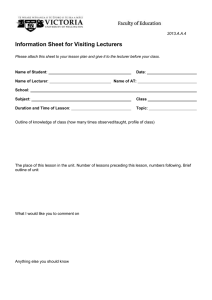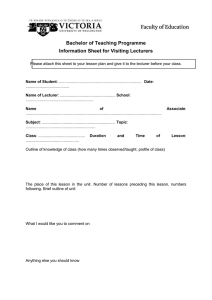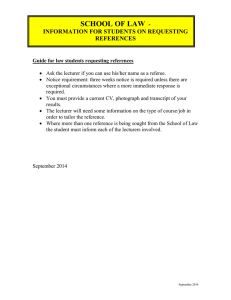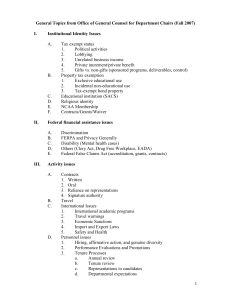LEARNING METHODS IN ACCOUNTING EDUCATION - TECSI
advertisement
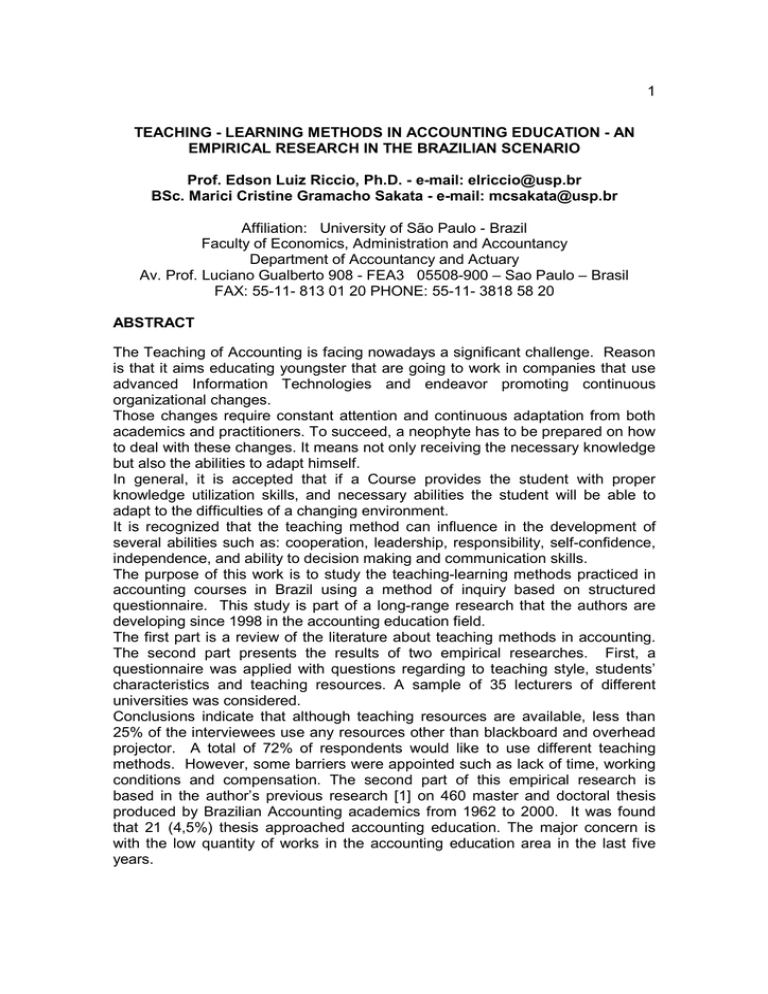
1 TEACHING - LEARNING METHODS IN ACCOUNTING EDUCATION - AN EMPIRICAL RESEARCH IN THE BRAZILIAN SCENARIO Prof. Edson Luiz Riccio, Ph.D. - e-mail: elriccio@usp.br BSc. Marici Cristine Gramacho Sakata - e-mail: mcsakata@usp.br Affiliation: University of São Paulo - Brazil Faculty of Economics, Administration and Accountancy Department of Accountancy and Actuary Av. Prof. Luciano Gualberto 908 - FEA3 05508-900 – Sao Paulo – Brasil FAX: 55-11- 813 01 20 PHONE: 55-11- 3818 58 20 ABSTRACT The Teaching of Accounting is facing nowadays a significant challenge. Reason is that it aims educating youngster that are going to work in companies that use advanced Information Technologies and endeavor promoting continuous organizational changes. Those changes require constant attention and continuous adaptation from both academics and practitioners. To succeed, a neophyte has to be prepared on how to deal with these changes. It means not only receiving the necessary knowledge but also the abilities to adapt himself. In general, it is accepted that if a Course provides the student with proper knowledge utilization skills, and necessary abilities the student will be able to adapt to the difficulties of a changing environment. It is recognized that the teaching method can influence in the development of several abilities such as: cooperation, leadership, responsibility, self-confidence, independence, and ability to decision making and communication skills. The purpose of this work is to study the teaching-learning methods practiced in accounting courses in Brazil using a method of inquiry based on structured questionnaire. This study is part of a long-range research that the authors are developing since 1998 in the accounting education field. The first part is a review of the literature about teaching methods in accounting. The second part presents the results of two empirical researches. First, a questionnaire was applied with questions regarding to teaching style, students’ characteristics and teaching resources. A sample of 35 lecturers of different universities was considered. Conclusions indicate that although teaching resources are available, less than 25% of the interviewees use any resources other than blackboard and overhead projector. A total of 72% of respondents would like to use different teaching methods. However, some barriers were appointed such as lack of time, working conditions and compensation. The second part of this empirical research is based in the author’s previous research [1] on 460 master and doctoral thesis produced by Brazilian Accounting academics from 1962 to 2000. It was found that 21 (4,5%) thesis approached accounting education. The major concern is with the low quantity of works in the accounting education area in the last five years. 2 INTRODUCTION The current accounting education scenario indicates the following major characteristics: a large number of accounting undergraduate courses, (more than 30 just in the City of São Paulo [4]); an increasing competition in the job market and the recently instituted examination applied by the National Council of Accounting as a mandatory requirement for certification. As a result, the search for higher quality in accounting education has become an important endeavour for all Brazilian education institutions. Dunkin shows that in at least 20 researches on the evaluation of instruction there are some evidence of the students' sensibility to the variation in teaching methods and “there is also evidence that teaching processes vary in the size of their effects upon student evaluation” [8]. Accordingly, choice of instruction method by lecturer should respond to it. Countless factors influence the lecturer in the choice of the resources and methods to be used in classrooms such as cost, subject area, preparation time, knowledge of the method, risk of non acceptance, students feedback, incentive from institution, characteristics of the group and others. These empirical research intents to investigate how the lecturers identify and approach these issues and also to understand how their choice of teaching methods is affected. It is part of a long-range research that the authors are developing since 1998 in the accounting education field. The first part of this work concerns to a review of the literature of existing methods and its characteristics. The second part presents the results of two empirical researches. In the first one a questionnaire was applied with questions regarding to teaching style, students' characteristics and available teaching resources. A sample of 35 lecturers from different universities located in different states was selected. The second one was based in the authors previous research [14] of all masters and doctoral thesis produced by Brazilian accounting academics between 1962 and 2000. It shows the amount of work in the education area produced by academics. The final results are discussed in the last part of the paper. BACKGROUND REVIEW For a better focus of analysis, brief concepts of learning style, teaching methods and educational resources are presented, followed by examples of usage by professors in different universities. 3 Learning style Learning can be understood as a process of changing behaviour [12]. Several studies have been developed on learning style of accounting and business students. One example is Kolb’s learning style model [10]. According to the author, learners rely on four different learning modes: Immediate concrete experiences (CE), Reflection and Observation (RO), Abstract Concepts (AC) and Activate Experimentation (AE). Teaching Method The choice and utilisation of teaching methods is different for each environment due to specific characteristics such as culture and historical background. The methods can be utilised in each different environment considered it is adapted to local characteristics. Popham [12] suggests a process to be used by lecturers in the business education area. In the Picture 1, he suggests how to work with the competencies detected by needs of the learner and needs of the business. Picture 1 - Teaching-learning systems for business education. 1. Identify and Classify competences Input Needs of the learner 2. Plan evaluations Needs of business 3. Constructing Performance Goals 4. Identifying and Sequencing Subcompetencies 5. Pretesting and matching Learner with Performance Goals and subcompetencies 6. Applying Appropriate Learning Principles 7. Select appropriate teaching-learning strategies 8. Evaluate student achievement & effectiveness of system Move to next performance goal Did student achieve? Yes No Revise and Modify 4 A great variety of teaching methods is available for accounting education. These methods can vary in several dimensions such as degree of Information Technology usage, active student learning, among others. Bonner [1] lists some Teaching Methods Available to Accounting Lecturers, (performed by students): 1. Read text 2. Read work-out example problems (or objective questions) 3. Listen to lecture/watch video 4. Watch demonstration 5. Listen to and participate in interactive lecture 6. Answer short objective questions 7. Write and answer questions 8. Work short numerical problems 9. Work longer, unstructured cases and problems 10. Discuss issues with other students 11. Conduct research 12. Make oral presentations and answer questions 13. Participate in demonstrations (role-playing, simulation games, experiments) The author also lists outdoor activities, visit to companies, internship, etc. and According to Duff [7] in a research conducted in England, the accounting teaching in the undergraduate level favours students with preferences to the theoretical learning. However, there is no direct relationship between the performance and the preference by the learning style. In this case, the accounting program can be wide, more innovative, and to adopt teaching methods that satisfy also those without preference for theoretical learning. Deppe [6] enumerates the necessary Competencies for a successful professional that the educator should have in mind during the teaching process: 1) Communication skills 2) Ability to develop and to distribute information 3) Ability to decision making 4) Accounting knowledge, auditing and taxation 5) Knowledge of business environment 6) Professionalism 7) Leadership development. Through the appropriate use of teaching methods, the lecturer is capable to make the students to acquire such competencies. In the following table, the authors try to establish the relationship between the teaching methods and its possible effects on competencies, as well as some impediments of its usage by lecturers, based on several researches in the subject. 5 Teaching Method 1) Traditional Lecture 2) Teamwork extra class 3) Teamwork during class 4) Case solving 5) Individual homework assignment 6) Library research 7) Individual assignment during class 8) Student seminar 9) Internet research 10) Computer based activities 11) Visiting companies Effects of Teaching Method in Skills development - Factors most affected Knowledge acquisition, integration with other students Cooperation, Leadership, Responsibility, structured group task, interdependence, communication skills, shared responsibility Cooperation (social and interpersonal relationship skills), Leadership, Responsibility. structured group task, interdependence, communication skills, shared responsibility Confidence, Oral communication skills, written skills, group interaction skills, cognitive benefits ( problem solving, judgment, deal with ambiguity, understanding of the real world, comprehension of material) Independence, written skills, organization, logical thought Independence (able to recognize when information is needed and have the ability to locate, evaluate, and use effectively the needed information) Independence, writing ability, organization, logical thought Self Confidence, Communications (speaking ability) skills, critical thinking, interpersonal skills Independence, technology interaction and experience Encourages exploration, selfexpression and feeling of ownership by allowing students to manipulate its components, contact with off campus and real business activities (CD-ROM and Systems) Instant feedback and evaluation, motivation, independence Contact with business reality, General Impediments for usage by lecturers - To instructor: the size of the class, time consumed by group work, problem of free riders in group situations., need of group reward and individual accountability for performance improvements to occur. To students: preparation time, frustration, intimidation in discussion To Instructor: preparation time, training time in method, time to evaluate students, loss of control in the classroom, unexpected occurrences, physical and emotional demands on instructor To course: need for precious technical background, time to cover a topic, difficulty to presenting new material and technical material. Available resources to research at. Training to access large data bases, multimedia, online bulletin boards, etc. Students previous background and knowledge of the subject. Classroom size, students’ intimidation. Media-enhanced classroom facility Media-enhanced classroom facility, preparation time, instruction time for both students and instructor, cost, flexibility 6 understanding of the business process In Brennan [2], the result of a research with accountants, two years after the end of the course, showed that most ranked as deficient their abilities acquired in the course such as: independence, self confidence, co-operation, sense of responsibility and leadership. Some of other interesting works about teaching methods are: Communication Skills:Zaid & Abraham [15], Mc Laren [11]; Case Study:Knechel [9] CAMPBELL, J. E. and W. F. Lewis [3]; Co-operative Learning: Ravenscroft et al [13]; Individual versus Teamwork Tasks Daroca & Nourayi [5], among others. Resources Resources comprise the materials and media used to implement or supplement the learning activities. The most commonly available resources are overhead projector, video, TV, Microcomputer (Lab room), projector, Internet, multimedia etc . Some authors state that there is no relationship between the outcome of the learning process and resources, such as Neville, Onah and Bukowski [5]. We, like many others understand that the resource can help to improve the method’s effectiveness. The resource does not have to be expensive or highly technological in order to be effective but it has to be adequately experimented. As an example, the lecturer should not use a media in the same format of the traditional lecture. RESEARCH METHOD In this research, data collection has been based in two techniques: 1. Structured Questionnaire - distributed to 35 accounting lecturers 2. Data from the database created in “Accounting Research in Brazilian Universities” - 1962 - 1999 [14]. PART I 1. Research Method The questionnaire focused the following topics: 1. Gender 2. Lecturer’s education background 3. Subject area and period 4. Resources available in the school 5. Student’s profile 7 6. Classroom management profile 7. Teaching Methods used during lectures 8. Time spent in academic and school administrative activities 9. Personal opinion about the teaching methods usage. The lecturers were also asked to express their personal experience. 2. Population and Sample The questionnaires were sent to a sample of 35 lecturers in different universities located in different cities in Brazil. 3. Research results 1. Gender Gender Female Male 20% 80% 2. Lecturer’s Education Background Accounting undergraduate course Other 26 12 Accounting graduate course Other 23 7 3. Subject area and period The following table presents the lecture’s subject area: 60% 50% 40% 30% 20% Other Cost Accounting Auditing Financial Accounting 0% Management Accounting 10% 8 Picture 2. Lecture’s Subject Area Period Period Day-time courses Night - time courses 29% 71% 4. Types of Resources used during Lecture Since lecturers are located in different Universities the black bars show the availability of the resource in the respective school. Picture 3 the shows availability and usage of the resource. 100% Available Resources 80% 60% 40% Others TV/VCR Internet Lap Top/Projector Overhead Projector Blackboard 0% Lab. Room 20% Resources used during Lectures Picture 3. Types of Resources used during Lecture 5. Student’s Profile The Lecturers teaching in day-time courses indicated that the majority of his students is below 25 years old, does not work or has a part time job. In general the students of night-time courses have a full time job and the age presents a wide variety. 6. Classroom management profile Using a scale from 1 to 5, while 1 means strongly disagreement with the statements and 5 means strongly agreement, the average points for the following statements are: 9 Statement It is important to impose rules on students Assignments deadline are important and must be respect I incentive my students to raise questions I am concerned about both what my students learn and how they learn I am interested in the students feedback about my lectures I try to get the attentions from students that shows low interest 3.7 4.0 2.9 4.9 4.4 4.2 All Lecturers in the sample have indicated as being concerned with how the students learn and what they are learning. They tend to agree with the need to be demanding for schedule and deadline adherence respecting the activities, and demonstrated high interest in receiving students' feedback. 7. Teaching Methods used during lectures 0% 20% 40% 60% 80% 100% Expositive lecture Teamwork extra class Teamwork during class Case solving Individual homework assignment Library research Individual assignment during class Students seminar Internet research Computer based activities Visiting companies Others Picture 4. Teaching Methods used during lectures The picture shows high predominance of traditional lecture. 8. Time spent in academics and school administrative activities The questionnaire covers hours spent in appointment with students, correction of exercises, assignments and exams, lecture preparation and school administrative activities. The responses showed a range from zero to twenty hours per week in each of the above topics, depending on the working period of the lecturer. In Brazil most of the lecturers in the accounting area also have another job in private or public companies. This is considered a teacher’s 10 valuable qualification by many accounting schools since it allows a field experience that can be beneficial to the teaching process. However it may impact the development of activities such class preparation, interaction with students outside the classroom. 9. Personal opinion about teaching methods usage Would like to change but does not know how to do it Would like to change but does not have resources to do it Would like to change but does not have time to do it Do not want to change Open answer - see bellow 6% 26% 17% 28% 23% Most of the lecturers that responded to the open answer reported to be in a process of switching to new method. Some of the lecturers reported that time availability is a barrier to learn and apply new teaching methods. Most of these have another job and informed that they do not get compensation for dedicating extra hours with class preparation, and do not feel motivated to do it. PART II 1. Research Methods The part II was based in the author’s previous research named “Accounting Research in Brazilian Universities - 1962 – 1999” [14]. with thesis and dissertations produced by Brazilian academics in the education topic: 21 works from 460 master's and doctoral thesis . The dissertations and thesis are from the following institutions: University of Economy, Administration and Accountancy, FEA/USP Master's degree (1970) and Doctorate (1962) ISEC / Getúlio Vargas Foundation/ RJ Master's degree (1984 - 1993) State university of Rio de Janeiro, UERJ Master's degree (1993) Pontific Catholic Universities, PUC/SP Master's degree (1978) 2. Results A total of 21 works cover the education area, which represents 4.5% of the total, while 43% are concentrated in the Management and Financial area. The list of these works is attached to this paper. 11 DISCUSSION The results indicate that although teaching resources are available in the schools represented by the sample, less than 25% of the interviewees uses any resources other than blackboard and overheard projector. A total of 72% of the lecturers would like to use different teaching method or are trying to. However, some barriers were pointed such as lack of time, working conditions and compensation. Only two of the 35 lecturers visit companies with the students. The traditional lecture is the most used method. The results show a usage of 94% of traditional lecture, while new technologies such as Internet research and Lab room presented a usage rate bellow 50%. This is somehow surprising considering that in real life, students are going to work with highly sophisticated accounting systems, such as those based in ERP, and using E-Commerce, B2B, and other integrated technologies. This may increase the gap existing between the school and practice and should be a concern for all educators. The second part of this research is based in an author’s previous research (14) of 460 master's and doctoral thesis produced by Brazilian accounting academics revealed 21(4,5%) works approaching accounting education. This is another major concern: the very few amounts of academic works in the accounting education area. They have all been produced after 1987. However there is no evidence of growth . This indicates that accounting education is still a marginal subject for Brazilian accounting schools. The evident reason is that in the researched schools, accounting education is not defined as one of the Research Areas in Master and Doctoral Programs, thus creating low interest for the subject. LIMITATIONS AND FUTURE RESEARCHES Additional work is required before a complete understanding of the scenario. New researches should be made on this subject, and other variables such as cost, knowledge, risk, receptivity, incentive among others must be included. ATTACHEMENTS FEA - Faculty of Economics, Administration and Accountancy (Master) EDUCATION AND THE JOB MARKET OF THE BACHELORS OF ACCOUNTANCY IN FORTALEZA CITY OLIVEIRA, Marcelle Colares (1995) 12 SIMULATION GAME APPLIED TO ACCOUNTING TEACHING BEPPU, Clovis Ioshike (1994) THE USE OF MICROCOMPUTERS IN THE TEACHING OF ACCOUNTING IN HIGH EDUCATION CARASTAN, Jacira Tudora (1986) FEA - Faculty of Economics, Administration and Accountancy (Doctoral) TEACHING ACCOUNTING BACKGROUND NOSSA, Valcemiro (1999) IN BRAZIL: A CRITICAL ANALYSIS OF THE FACULTY CONTRIBUTION FOR THE IMPROVEMENT OF THE QUALITY IN ACCOUNTING HIGHER EDUCATION VASCONCELOS, Nanci Pereira (1995) TEACHING ACCOUNTING USING MICROCOMPUTERS, BASIC AND SPREADSHEETS: ANALYSIS OF AN EXPERIENCE IN MASTER'S DEGREE SPINOSA, Wilson da Silva (1988) ELECTRONIC ISEC - FGV - Master (Course ended in 1993) AN EXPERIMENTAL STUDY ON THE USE OF THE COMPUTER SCIENCE IN THE TEACHING OF THE ACCOUNTING PIRES, Luiz Gonzaga Barbosa HIGHER EDUCATION IN ACCOUNTING IN THE STATE OF PARANÁ: A CASE STUDY FAVERO, Hamilton Luiz (1987) TEACHING OF ACCOUNTING IN BELO HORIZONTE: A COMPARATIVE STUDY PACHECO Filho, Jose Gomes (1988) TEACHING OF ACCOUNTING IN THE BRAZILIAN UNIVERSITY COSTA, Jose Mario Ribeiro da (1988) THE HIGHER EDUCATION OF ACCOUNTING SCIENCES IN THE STATES OF MATO GROSSO AND MATO GROSSO DO SUL: CASE STUDY MESQUITA, Luiz Carlos de. (1988) ANALYSIS OF THE PROCESS OF ADAPTATION TO THE JOB MARKET UNDERGRADUATE STUDENTS FROM ACCOUNTING UNIVERSITIES IN BRAZIL LEITE, Isler Silveira. (1989) OF THE HIGHER EDUCATION OF ACCOUNTING MADEIRA, Geova Jose (1990) OPINIONS AND EXPECTATIONS OF LECTURERS AND STUDENTS IN ACCOUNTING COURSES AT PARAÍBA: AN EXAM OF GOMES' PROPOSALS AND HANDEL GRANGEIRO, Gilvan Tavares. (1990) 13 HIGHER EDUCATION OF ACCOUNTING IN CHILE: A STUDY TO IDENTIFY RELATED ASPECTS ATIENZO Soto, Miriam Duyanira. (1990) UERJ – State University of Rio de Janeiro – Master SYSTEMS AUDITING TEACHING IN ACCOUNTING COURSES ALVES, Francisco José S. (1998) THE HIGHER EDUCATION IN ACCOUNTING IN RIO DE JANEIRO - A CASE STUDY MARTINS, Norma Suely (1993) THE EVOLUTION OF THE TEACHING OF ACCOUNTING AND THE SOCIOECONOMIC CONTEXT IN RIO DE JANEIRO COSTA, Rosemar de Jesus (1995) THE HIGHER EDUCATION IN ACCOUNTING IN THE STATE OF PIAUÍ SOUZA, Ceciane Portela (1993) PUC - Pontific Catholic Universities - Master APPLIED DIDACTICISM TO THE TEACHING OF ACCOUNTING IN HIGH EDUCATION FAVARIN, Antônio Marcos (1994) METHODOLOGICAL ASPECTS ACCOUNTING PADOVEZE, Clovis Luiz (1992) OF THE TEACHING DISCIPLINE OF MANAGERIAL REFERENCE [1] BONNER, S. E., Choosing Teaching Methods Based on Learning Objectives: An integrative Framework Issues in Accounting Education, Vol. 14 No. 1 February 1999. [2] BRENNAN, W. P. e MCGEEVER, P. Graduates at work: degree courses and the labour market, London: Jessica Kingsley Publisher, 1988. [3] CAMPBELL, J. E. and W. F. Lewis, Using cases in accounting classes, Issues in Accounting Education, Fall, 1991 pg. 276-283. [4] CRC – Conselho Regional de Contabilidade do Estado de São Paulo [5] DAROCA, F. & NOURAYI, M. M. Some performance and Attitude Effects on Students in Managerial Accounting: Lecture vs. Self-Study Courses, Vol. 9 No. 2 Fall, 1994, pg. 319-329 [6] DEPPE, L. A. et ali, Emerging Competencies for the practice of accountancy. Journal of Accounting Education (Fall): pg.257-290, 1991 14 [7] DUFF, Angus, The impact of Learning strategies on Academic performance in an accounting undergraduate course, British Accounting Association BAA-SIG, Discussion Paper, No. 8 October 1995. [8] DUNKIN M., BARNES, J. Research on Teaching in higher Education, Handbook of Research on Teaching, Third Edition, MacMillan Pub. Company, 1984. p.768-774 [9] KNECHEL, W. R. Using the Case Method in Accounting Instruction. Issues in Accounting Education 7 (2) 205-217, 1992 [10] KOLB, D.A. “Experiential Learning - Experience as the Source of Learning and Development” Prentice Hall 1984, USA [11] MCLAREN, M.C. The place of communication skills in the training of accountants in New Zealand, Accounting and Finance, 30, 83-94, 1990 [12] POPHAM, E.L., SCHRAG, A. F., BLOCKHUS, W. A Teaching-Learning System for Business Education, Gregg Division McGraw-Hill Book, 1975 [13] RAVENSCROFT et al, Incentives in Student Team Learning: An experiment in Co-operative Group Learning, Issues in Accounting Education, 10 (1) 97-110, 1995 [14] RICCIO, E.L., SAKATA, M.C.G, CARASTAN, J. Accounting Research in Brazilian Universities - 1962 - 1999, Caderno de Estudos, n.22, 2000 [15] ZAID O. A. e ABRAHAM, A, Communication skills in accounting education: perceptions of academics, employers and graduate accountants. Accounting Education, 3, pg.205-221, 1994
